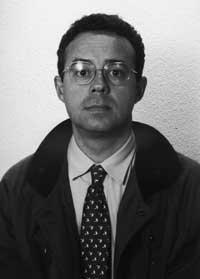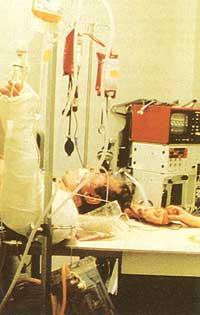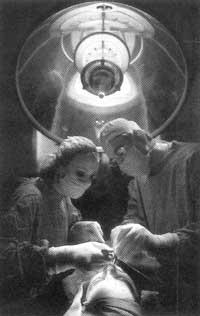Coordinated continuous medical emergency assistance
1998/05/01 Unanue, Txema | Ibarguren Olalde, Karlos Iturria: Elhuyar aldizkaria
Specialized care leaves the hospital
When calling the emergency phone and checking that at 5 or 6 minutes three people dressed in green enter the house, the reaction between amazement and fright is usually frequent.
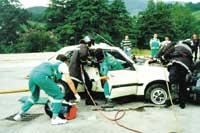
Each in hand bag, various gadgets, oxygen cylinder, etc. When he takes him, from there they enter asking if they have called the hospital and where the patient is. Immediately after overcoming the first reaction and before arriving at the hospital, seeing that you are offered the main care in the same place where you are, it is also common to start progressive relaxation.
In addition to clinical history and exploration, we can perform many tests that can help, including electrocardiogram. We can also obtain treatments such as drugs, oxygen, serums, cardioversion of lethal arrhythmias, respirator... When the situation itself requires something else (analysis, x-rays, observation, hospitalization...) the patient is hospitalized.
However, in this case time is lost and the patient is asked to be transferred to the hospital as soon as possible. Fortunately, more and more are those who understand that this is a special service that can offer very advanced care systems in the place of accident or illness, than a simple transportation system.
Professional equipment
When we go to the hospital, we do not doubt that there the professionals pay attention. Outside of this, we consider it normal to make it available to volunteering. It must be taken into account that after a serious accident the first hour (it is not said in vain the “golden hour”) is the most important and is then when most of the deaths occur.
It is true that in many cases death is inevitable, regardless of treatment, but in cases where something can be done, knowledge, experience and technical means are fundamental. The same can occur in cases of respiratory failure, acute myocardial infarction (AMI), cardiopulmonary arrest (CPR), or similar causes that make the hospital stay too far. The first task is to avoid death and it is also very important that the patient arrive at the hospital in adequate conditions to accelerate his recovery.

The service models vary depending on the ambulance staff. In one vertex is placed the model of the US and in the other the model of the French State. In the first one the “paramedics” attend with different level of training and once the patient’s situation stabilized, he is always transferred to the hospital. In the second, doctors and nurses who work in the hospital themselves attend and solve the problem in cases where it is possible; if this is not possible, the patient will be transferred to the hospital and attended by the same staff.
In the Autonomous Community of the Basque Country we have a mixed model. The Special Care Mobile Unit (UAI) is made up of auxiliary personnel, nursing and medical personnel. The assistant, in addition to driving the ambulance, participates directly in the assistance with the nurse and the doctor. Unlike the French State, it is not personal who leaves the hospital, but from the ambulance itself. Subsequently, in the hospital the work will be coordinated and they will be in contact, but will be in charge of another working group.
These units are called medicalized ambulance, but as we have seen, the ambulance staff is a team and their work has a collective character; without the support of others, the work of a single would have no sense or influence and, therefore, it can be the right time to start changing its name.
A territory, many models
The assistance organization is an indicator of the fragmentation of our country. In the north, Bayonne is the main nucleus. In it are the ABUM and, although they belong to the police, they use the helicopter frequently for health care. In Navarra Osasunbidea has located three ABUMS in Pamplona, Estella and Tudela. In the CAPV, Osakidetza, for its part, has five Historical Territories: Vitoria-Gasteiz, Laudio, Leioa, Valle de Trampago and Donostia-San Sebastián; in addition, in Gipuzkoa Tolosa and Elgoibar Osakidetza has two other units concerted with the cooperative Gipuzkoa Ancia.
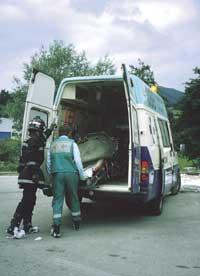
As all this indicates, it still takes a little longer to reach certain places and in order to improve the service, it is working in two areas: on the one hand, the installation of more ABUM is not excluded and, on the other, it ensures the presence of a normal ambulance of basic assistance, which offers a primary assistance until the arrival of the specialized service. Sometimes the joint vision of the two services generates tenderness and amazement, but only seeks to improve the results.
However, we should not think that this new service can deal with any problem. When calling the emergency service, the call receiver (doctor or operator) decides, depending on the case, the response to follow (see chart below).
Assistance anywhere
Analyzing the services provided by the ambulance of Donostia-San Sebastián in the last six months of 1996, it is observed that most of the assists were related to loss of knowledge (19%). Although there are lipoids without anxiety, there may be cardiopulmonary arrest or other severe arrhythmias and, if a rapid response is given, it has been possible to stimulate more than a year of stopping.
In the second level are the dyspnea (17%) and in the third the accidents (15.4%). In this last group it is very important to try to stabilize the patient on his way to the hospital, since this service allows many patients who would die on the way to arrive alive. The ABUM service has allowed to increase the number of organ donors to the arrival of many patients in a situation known as cerebral death.

Chest pain (15%), acute cerebrovascular accidents (PCI) (2.5%) and the rest of pathologies are also frequent in this service. In addition, among our functions is the transfer of patients from one hospital to another, especially in those cases where the serious patient requires treatments, surveillance measures or special tests.
It is true that with our sirens, noises, prey, etc. The drivers get nervous and often we alter the pedestrians, as it shows us more than one with its representative gestures. However, if what has been altered had requested the service, the time it would take to arrive would be inexhaustible, so we request its understanding. Although many do not believe it, we try to give a response as soon as possible, but moving from one place to the next with speed, certainty and little discomfort is not easy.
“Christmas Emergency”

It is the operator who has taken the phone at 03:25 am. On the other side, the one who is loaded with problems and frightened by a system he does not know, and full of anxiety, cannot make clear what his concern is: “The mother is wrong, she sends an ambulance.” The operator intends to reassure and although for technical reasons communication is interrupted, requests the phone number of the caller in order to attend the request.
Despite their ignorance on the part of the majority of the population, these coordination centers are the backbone of emergency care and the urgency that is offered in the ACBC. Twenty-five years ago, Osakidetza collected requests for help through emergency phones (Araba 945 24 44 44, Bizkaia 94 410 00 00 and Gipuzkoa 943 46 11 11) and created the centers that address these situations. At present, in addition, the sanitary calls received in the service SOS-Deiak (008) are transferred to the stands of Osakidetza so that they can be attended in case of accident or other.
In it are the operators and doctors with experience in emergency services. Depending on the problem and after analyzing the possibility of the patient approaching a proper health center, an adequate response is facilitated: sending of staff or telephone response.
“What can I help you in?”
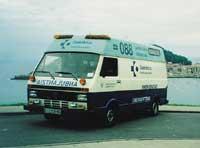
Once received the phone from the caller, the operator passes the call to the doctor explaining the reasons for the consultation. The doctor then opens a brief clinical history: what your age is, what happens to you, what diseases you have had before, if you have had something similar before, if you are taking medicines...
In order to decide which is the best way to deal with the problem, the doctor needs information and asks for all these data. The models of care that you can manage from it are:
- Physicians and domestic emergency nurses.
- Mobile Special Attention Units (U.T.M.) with doctors, nurses and auxiliaries.
- Basic ambulances: Emergency sanitary transport network (LOGS) and concerted.
The consultation is not always resolved by sending the doctor home. Other tests may also be appropriate (x-rays, analysis, etc.) transfer to a health center for its realization. When the circumstances require it, an ABUM can be mobilized with special attention.
“Don’t worry, in 5 minutes you will have help”
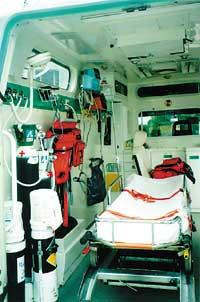
He tells us that the patient is a 75-year-old bronchopata and that even if he takes medications, breathing acuity has not improved. The medical coordinator decides to send an ABUM. However, before hanging the phone, you are informed of the physical exercise that can improve your state until the ambulance arrives to take another two doses of the medication you take. Its endowment will analyze the medication and treatment of oxygen and assess whether the patient is hospitalized.
Through the telephone or radio, the coordination center will contact the mobile units. The reason for the consultation is explained and the patient's data and the rest of the information necessary for the correct performance of their work are provided. Subsequently, once the service is completed, the ambulance communicates the diagnosis and treatment to the center.
In fact, the center makes a bridge between the ambulance and the hospital: when sick people arrive with serious processes, everything must be prepared in the hospital, without losing the time that can be vital.
“UTE 3.602”
The medical ambulance by radio is put in contact with the coordinating center: “We took the patient with acute respiratory failure to the Arantzazu Hospital.” It will leave the patient and then collect in the incidence part the precise diagnosis, home and road treatment and other data.

Gai honi buruzko eduki gehiago
Elhuyarrek garatutako teknologia



